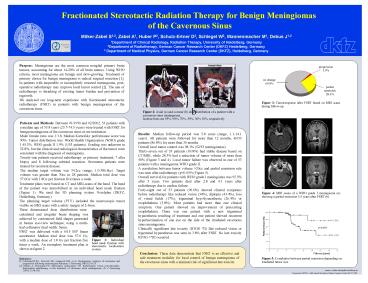Kein Folientitel - PowerPoint PPT Presentation
1 / 1
Title:
Kein Folientitel
Description:
Using WHO criteria, most meningioma are benign and slow-growing. ... S1,2, Zabel A1, Huber P2, Schulz-Ertner D2, Schlegel W3, Wannenmacher M1, Debus J1,2 ... – PowerPoint PPT presentation
Number of Views:18
Avg rating:3.0/5.0
Title: Kein Folientitel
1
Fractionated Stereotactic Radiation Therapy for
Benign Meningiomas of the Cavernous Sinus
Milker-Zabel S1,2, Zabel A1, Huber P2,
Schulz-Ertner D2, Schlegel W3, Wannenmacher M1,
Debus J1,2 1Department of Clinical Radiology,
Radiation Therapy, University of Heidelberg,
Germany 2Department of Radiotherapy, German
Cancer Research Center (DKFZ) Heidelberg,
Germany 3 Department of Medical Physics, German
Cancer Research Center (DKFZ), Heidelberg, Germany
Purpose Meningioma are the most common nonglial
primary brain tumors, accounting for about 14-20
of all brain tumors. Using WHO criteria, most
meningioma are benign and slow-growing. Treatment
of primary choice for benign meningioma is
radical surgical resection 1. In patients with
inoperable or incompletely resected meningioma,
post-operative radiotherapy may improve local
tumor control 2. The aim of radiotherapy is
shrinking of existing tumor burden and prevention
of regrowth. We analysed our long-term
experience with fractionated stereotactic
radiotherapy (FSRT) in patients with benign
meningiomas of the cavernous sinus.
progression 1.9
no change 69.8
partial remission 28.3
Figure 3 Tumorresponse after FSRT based on MRI
scans during follow-up
a
b
Figure 2 Axial (a) and coronar (b) dose
distribution of a patient with a cavernous sinus
meningioma. Isodose lines are 95, 90, 70,
50, 30 10, respectively
Patients and Methods Between 01/1990 and
02/2002, 53 patients with a median age of 53.8
years (23.7-74.5 years) were treated with FSRT
for benign meningioma of the cavernous sinus at
our institution. Male/ female ratio was 13.8.
Median Karnofsky performance score was 90. Tumor
distribution was World Health Organization (WHO)
grade I 45.3, WHO grade II 1.9 (1/53 patients).
Grading was unknown in 52.8, but the clinical
and radiological characteristics of the tumor
were consistent with the diagnosis of
meningioma. Twenty-one patients received
radiotherapy as primary treatment, 7 after biopsy
and 8 following subtotal resection. Seventeen
patients were treated for recurrent disease. The
median target volume was 34.2cc (range,
1.0-386.8cc). Target volume was greater than 30cc
in 28 patients. Median total dose was 57.6Gy with
1.8Gy per fraction five times a week.
Results Median follow-up period was 5.8 years
(range, 1.1-14.1 years). All patients were
followed for more than 12 months, 46/53 patients
(86.8) for more than 36 months. Overall local
tumor control was 98.1 (52/53 meningiomas).
Thirty-seven out of 53 patients (69.8) had
stable disease based on CT/MRI, while 28.3 had a
reduction of tumor volume of more than 50
(Figure 3 and 4). Local tumor failure was
observed in one of 53 patients with a meningeoma
WHO grade II. A correlation between tumor volume
gt20cc and partial remission rate was seen after
radiotherapy (plt0.059) (Figure 5). Overall
survival for patients with WHO grade I meningioma
was 95.5 after 5 years. Two patients died after
2.8 and 4.1 years after radiotherapy due to
cardiac failure. Forty-eight out of 53 patients
(90.6) showed clinical symptoms before
radiotherapy like reduced vision (34), diplopia
(43.4), loss of visual fields (17), trigeminal
hyp-/dysaesthesia (26.4) or exophthalmia (3.8).
Most patients had more than one clinical symptom.
One patient showed an improvement of preexisting
exophthalmia. There was one patient with a new
trigeminal hypaesthesia resulting of treatment
and one patient showed recurrent hyperlacrimation
of one eye on the side of the irradiated
cavernous sinus meningeoma. Clinically
significant late toxicity (RTOG II) like reduced
vision or trigeminal hypaesthesia was seen in
3.8 after FSRT. No late toxicity RTOG gtIII
occurred.
a
Treatment plans were based on CT and MRI-scans of
the head. The head of the patient was immobilized
in an individual head mask fixation (Figure 1).
We used the 3D planning system Voxelplan (DKFZ,
Heidelberg, Germany). The planning target volume
(PTV) included the macroscopic tumor visible on
MRI scans with a safety margin of 2-3mm. Three
dimensional dose distributions were
b
Figure 4 MRI scans of a WHO grade I meningioma
(a) showing a partial remission 3.5 years after
FSRT (b)
calculated and irregular beam shaping was
achieved by customized field shapes generated in
beams eye-view technique, using a multi-leaf
collimator (leaf width 5mm). FSRT was delivered
with a 6/15 MV linear accelerator. Median total
dose was 57.6 Gy, with a median dose of 1.8 Gy
per fraction five times a week. An exemplary
treatment plan is shown in figure 2.
Figure 1 Individual head mask fixation with
stereotactic localisation system
Conclusion These data demonstrate that FSRT is
an effective and safe treatment modality for
local control of benign meningioma of the
cavernous sinus with a minimal risk of
significant late toxicity.
References 1 Mirimanoff RO, Dosoretz DE,
Linggood RM, et al. Meningioma Analysis of
recurrence and progression following
neurosurgical resection. J Neurosurg
19856218-24. 2 Sibtain A, Plowmann PN.
Stereotactic radiosurgery VII. Radiosurgery
versus conventionally-fractionated radiotherapy
in the treatment of cavernous sinus meningiomas.
Br J Neurosurg 199913158-166.
Figure 5 Correlation between partial remission
depending on irradiated tumor size
contact s.milker-zabel_at_dkfz-heidelberg.de
Presented at ASTROs 46th Annual Meeting in
Atlanta, Georgia, October 03-07, 2004































